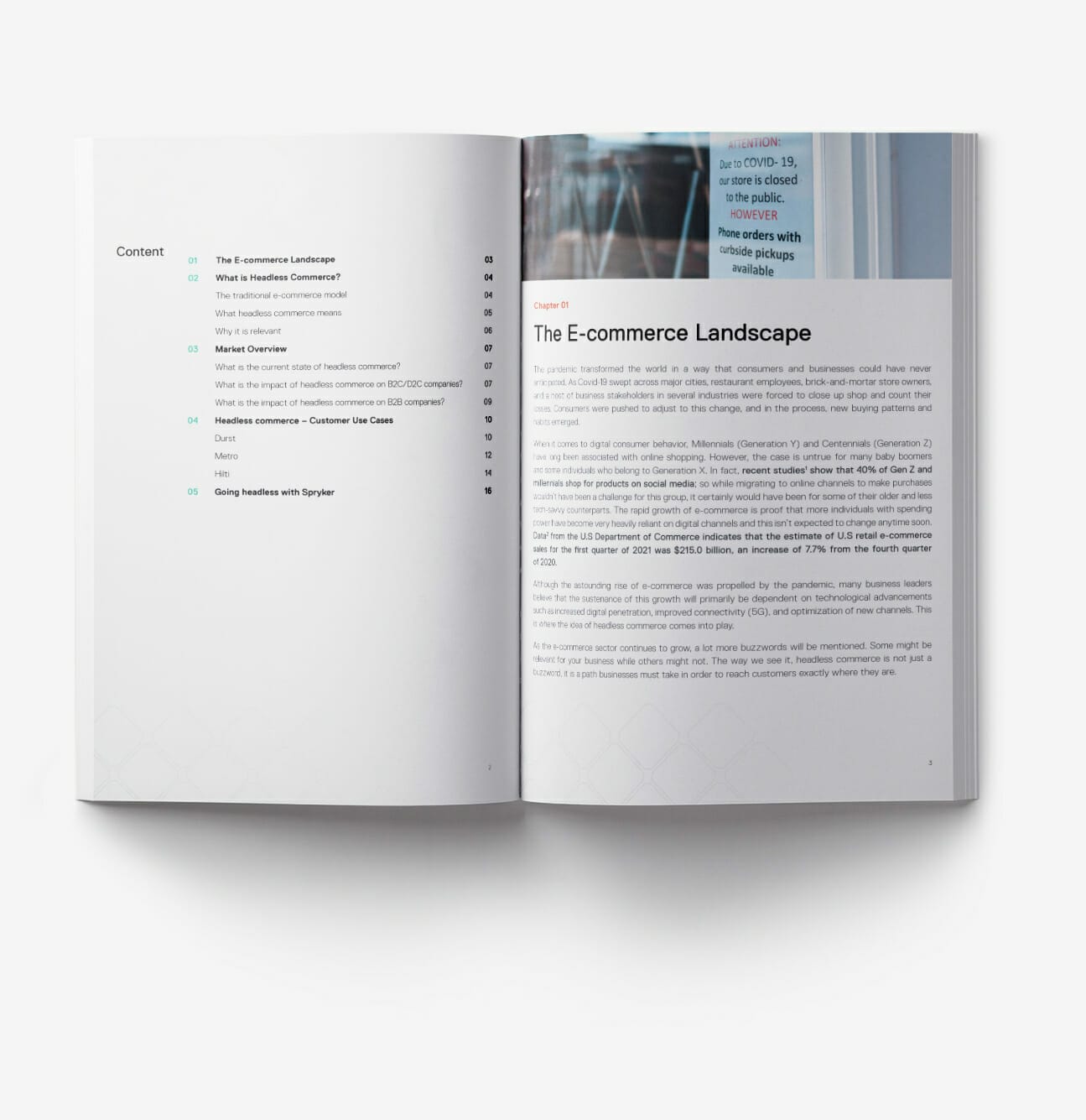Headless Commerce
Headless commerce is a separation of the front end and back end of ecommerce applications. The headless commerce technology offers companies the freedom of to build without limits and enables them to significantly improve the customer experience.

What Headless Commerce Means
Headless commerce is a term that describes an e-commerce solution where the front-end (customer-facing layer or storefront) is consistently separated from the back-end (where all the functionalities are controlled).
The result is components that function independently of each other. For communication, interfaces (APIs) are used to connect the components and deliver content to the user.
Traditional e-commerce platforms are often monolithic in nature. In other words, the front-end is tightly coupled with the back-end system, and the features cannot be individually customized or changed, since the whole system is working like one huge unalterable block.
A headless eCommerce system works by passing requests between the presentation and application layers through web services or application programming interface (API) calls.
In the early stages of e-commerce, businesses relied on these monolithic architectures as they brought their stores to life. However, the lack of flexibility with such systems often caused customization complexities and slower iteration cycles. If developers wanted to make improvements to the front-end, they would have to alter the back-end as well. The risk of ruining the entire system confined developers to these all-in-one structures.
For businesses that require basic online stores with less frequent product updates and little to no customization, the traditional e-commerce model works just fine. However, in today’s rapidly changing, consumer-driven world, a headless commerce approach is relevant for businesses that desire to not only scale but scale quickly.
Benefits of Headless Commerce
Between traditional and headless commerce, headless commerce seems to be a much better option in terms of customer experience.
-

Flexibility
Headless commerce is all about the flexibility of storefront customization and the development of countless front-end interfaces. This is good news for developers as they are no longer limited by pre-existing front-end platforms; they can build new customer-facing platforms from scratch taking into consideration the experience they would like customers to have. In other words, flexibility gives room for a richer user experience. Furthermore, developers would no longer be frightened by unintended changes to back-end systems, as they attempt to modify the presentation layer. By adopting a headless approach, you can make updates safely knowing that the two entities are independent of each other.
-

Customization & Personalization
Consumers want to be reached on the channels they utilize the most – whether it is social media or an IoT device, they would rather place items in their carts or approve transactions at their convenience. Headless commerce greatly supports the idea of personalization and your business has the potential to create custom experiences and refine them as time progresses.
-

Speed and time to market
Headless commerce guarantees faster time to market. In some cases, a shorter time to market could also mean fewer tests and reduced costs for the business. Updates can take weeks or days with traditional commerce systems. Headless commerce allows businesses to reduce the amount of downtime. As an example of headless commerce, Amazon and its developers deploy code every 11.7 seconds.
When the front-end and back-end are decoupled, there is no need to refresh the entire system. This helps your brand to publish information that is requested by your customers faster, which ensures your brand's competitiveness in the market. -

Omnichannel Experience
Multiple touchpoints allow for a more seamless customer journey. In fact, through API, the headless commerce solution can easily integrate and communicate across multiple platforms. The ability to reach customers on various channels without having to make major architectural changes is a huge benefit of headless commerce. Customers can easily migrate from one platform to the next while still enjoying similar experiences. Knowing that accessing a headless commerce platform doesn’t interfere with ordinary routine can help drive purchases by customers. These days, customers are all about convenience and a headless approach can enable a business to better respond to this need.
-

Agility and seamless integrations
In today’s business environment, agile methodologies or processes are required in order to scale. Customers are constantly changing and businesses need to evolve with them. Headless commerce makes it possible to not only adopt new technologies such as IoT devices; it also allows for the integration of new systems, such as payment platforms, Customer Relationship Management tools, and Content Management Systems. And it only takes a few hours to integrate the platform with these new systems. Being nimble is all about meeting new customer demands as they come. Headless commerce systems ensure that you can update information about the latest products and campaigns for your customers without having to edit the back-end. Plus, it's easy to change everything to keep up with the fast pace of customer technology.
HEADLESS COMMERCE RESOURCES
Learn more about Headless Commerce
Join our Headless Commerce Masterclass
What is headless commerce? Is it the right solution for your business? This 5 piece masterclass will walk you through the benefits of headless commerce compared to the traditional commerce, highlighting the main differences between the two approaches, and showing how Spryker can help you go headless and stay innovative, without pain.
Sign Up







